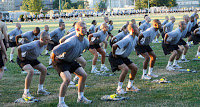illness among new military enlistees.
DA, Deuster PA, O’Connor FG, and Kurina LM. Med Sci Sports Exerc. 2018. [Epub Ahead of
Print].
Cases of mild and severe heat illness are more likely to occur in the first 6
months of activity and are also associated with younger age and body mass index
(low and high).
To help prevent heat illnesses, a potentially
life-threatening condition, clinicians need to understand when heat illnesses
occur and who is at greater risk. Therefore, Nelson and colleagues completed a
retrospective study to determine who is more likely develop heat illness among 238,168
US Army soldiers who enlisted between January 2011 and December 2014. The authors reviewed records of outpatient and inpatient care to identify heat
illness events and potential predictors of heat illness. The authors identified
cases of mild heat illness and severe heat illness using International Classification of Disease, Ninth Revision, Clinical Modification (ICD-9-CM)
codes. Potential predictors were sex, age, race, marital status, Army Physical
Fitness Test score, Armed Forces Qualifying Test score, months of military
service, prescribed medications, body mass index, tobacco use, history of prior
heat illness, geographical location of service, and time of the year. Overall, enlistees
experienced 2,612 cases of mild heat illness and 732 cases of severe heat
illness. Most heat illness events occurred during the first 6 months of service
(71% of mild cases and 60% of severe cases). An enlistee with a history of severe
heat illness, high (obese) or very low body mass index, lower age, and lower Armed
Forces Qualifying Test score was more likely to develop a mild heat illness.
Furthermore, an enlistee who used tobacco or took nonsteroidal
anti-inflammatory drugs, opioids, or methylphenidate was also more likely to
develop a mild heat illness.
both modifiable and non-modifiable factors associated with an increased risk of
heat illness. One key finding was the high number of heat illnesses that
occurred during the first 6 months of service. Hence, clinicians may need to
promote prevention efforts at the start of service. This may be particularly
important when an enlistee is younger, obese, underweight, using certain
medication, or has a history of heat illness.
Interestingly, the Army Physical Fitness Test scores were unrelated to
heat illness, which may indicate that it plays a lesser role in identifying who
is at risk than other factors like a person’s history of heat illness or body
mass index. It should be noted though, that the study population may not be generalizable
to all physically active people; yet, the data presented can be useful to clinicians.
For example, while we often focus on proper conditioning to prevent heat
illness, these findings should make us pause and consider how we are addressing
other important risk factors. Overall, clinicians should screen physically
active individuals for medication use, tobacco use, history of heat illness,
and body mass. Furthermore, they should be proactive in promoting prevention
efforts when a person engages in new physical activities.
what you have seen in your clinical practice?

